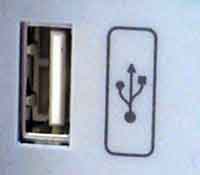How to add USB ports to your PC
Question: I’ve run out of USB plugs on my computer! I have a USB printer and USB scanner, and now a USB connector for my camera. So, now what? – A.V.
Answer: Well, you can plug and play – just swap them as you need to. But more conveniently, you can buy a USB hub for about $30 US or less.
In the past few years, just about all new computers have been equipped with at least two USB ports. In case you’re new to a USB connector, they look like this: 
Read this TechnologyTips article for more information on Computer Ports and Connectors: A Quick Reference.
Here’s a brief explanation of USB technology and how to make the most of it on your system. USB (for Universal Serial Bus) is a type of port used for data transfer from peripheral hardware into your system. What makes it valuable is that devices connecting through it do not need to be assigned an IRQ (kind of an address on a computer for devices) by the computer. What this means is that a system using Windows can free up resources and therefore be more efficient when fewer devices or peripherals need to have specially allocated assignments in order to run.
When USB was first introduced, the only common devices that used it were mice, digital cameras, and printers. Now, it’s the most common connection technology on a computer and accepts everything from scanners to external hard drives, even telephones. So when you need more USB ports than your system has installed, get a USB hub. A hub is essentially like a telephone or electrical power outlet splitter; it allows more than one device to connect to a single slot. Most hubs come with four ports, heck, some even come with seven ports. If you run out of ports on your hub, you can string hubs together like holiday lights. The maximum number of devices you can connect to one USB port is 127. Pretty impressive, don’t you think?
Hubs come in two basic varieties – powered and unpowered. Some devices that access a USB port, such as printers and scanners, have their own power supplies so they don’t need power to come from the computer. Hubs come in a variety of sizes and colors, from desktop units to laptop hubs (Keyspan mini-hubs). Some are even stackable.
USB ports only have a limited ability to power devices that are plugged in, about 500 milliamps at 5 volts, so you’ll want to shop for a hub that takes into account the hardware you wish to hook up if you plan to use USB devices that draw their power from your computer (as opposed to those that have plug into external power).
The other excellent feature provided by USB technology is the ability to multitask. USB has a big enough data capacity, up to 1.5 megabytes a second, that you could potentially operate a scanner and a printer at the same time without the system hanging.
If your computer is older and has no USB ports, don’t worry. There are PCI adapter cards that will, after a simple upgrade, allow you to connect USB devices to your system, some of which will even allow you to use the newer USB standard known as 2.0. With a maximum throughput of 60 megabytes per second, USB2.0 is 40 times faster than the first generation USB ports. Just about all USB 2.0 ports are backwards-compatible with older generation devices, but newer devices that require USB 2.0 will not work with those first-generation ports.
